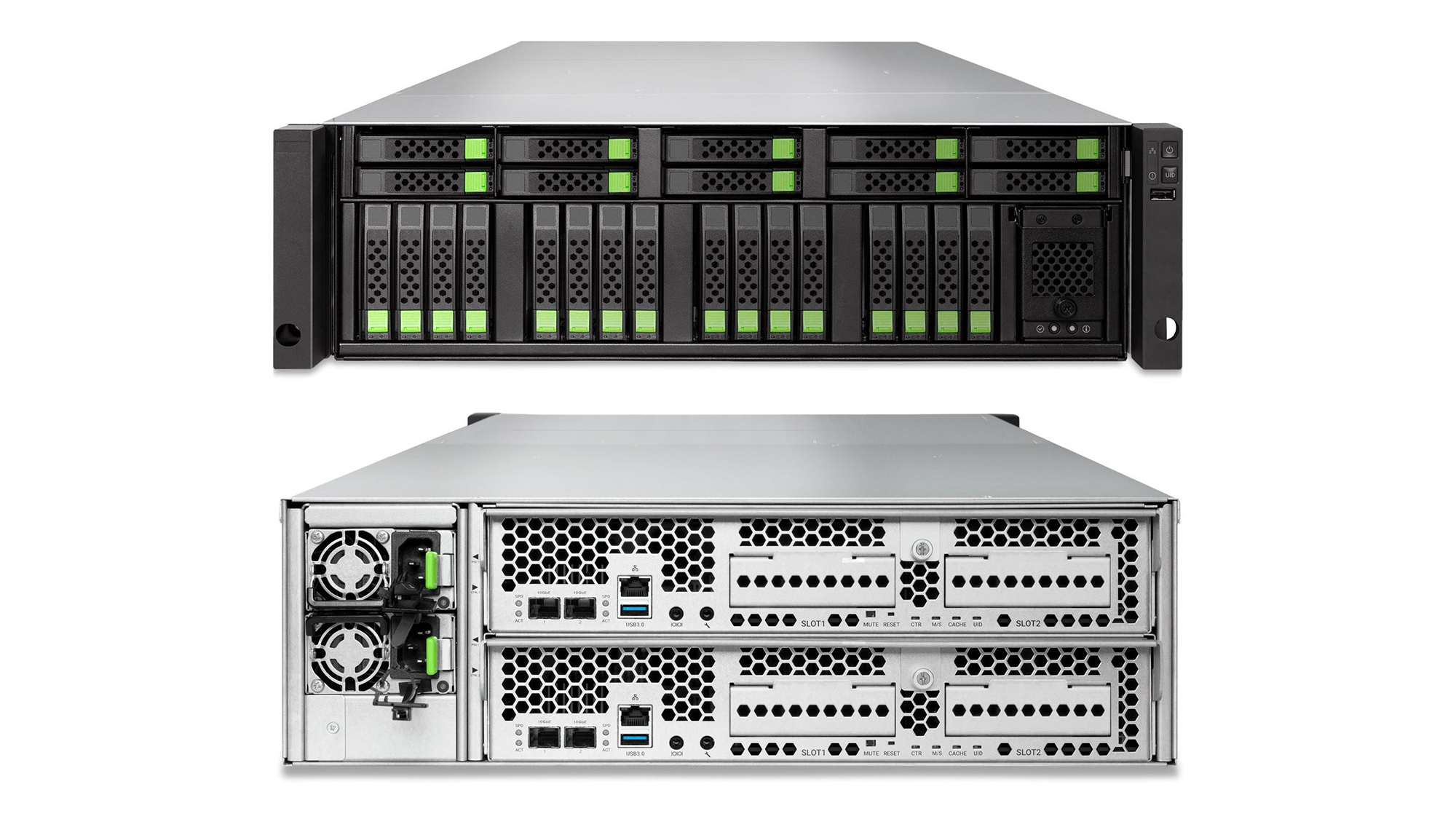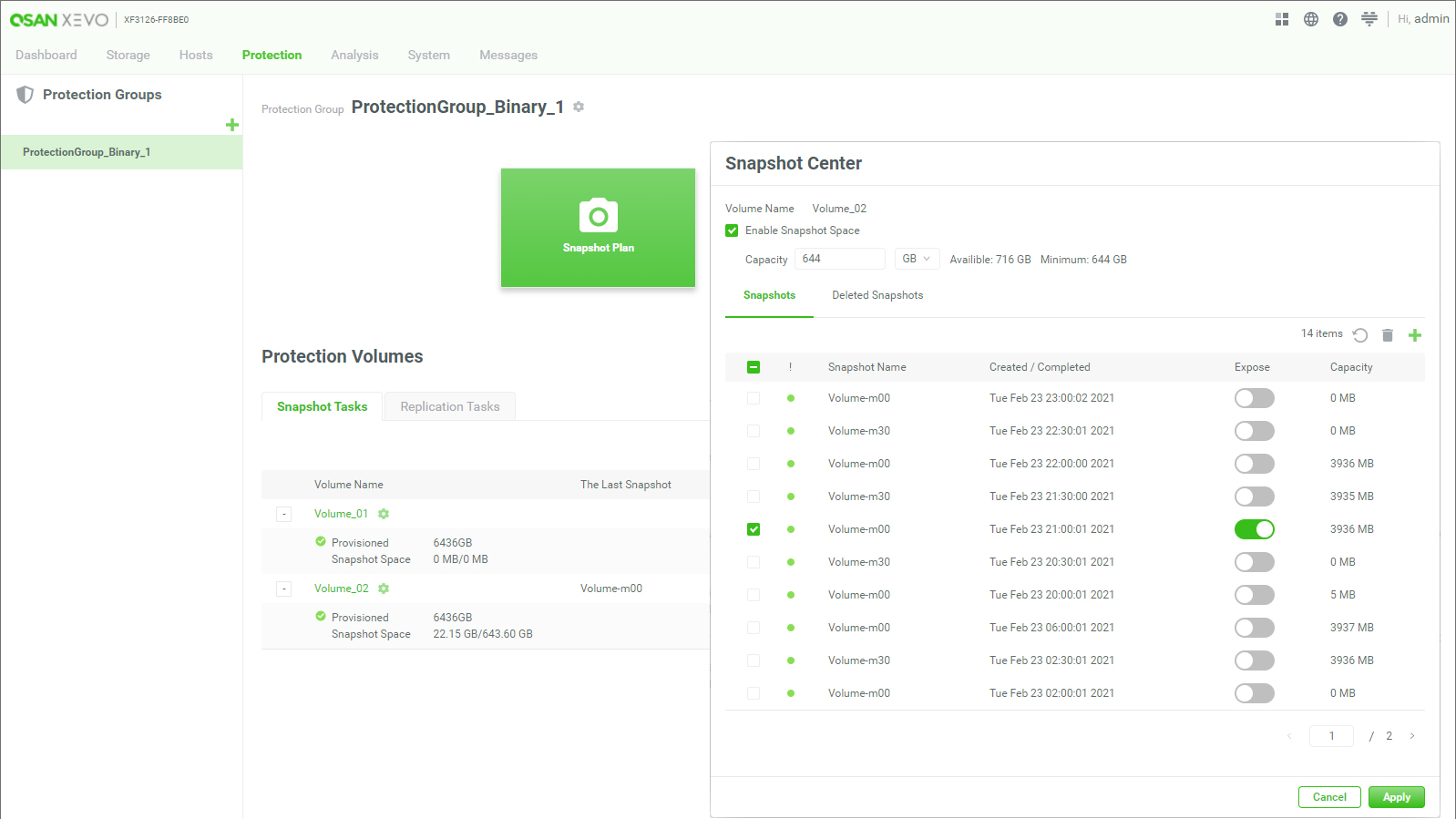Qsan XCubeFAS XF3126D review: The price is right
Qsan delivers an enterprise-class NVMe AFA at an SMB price


-
+
Great value
-
+
Xeon Scalable CPUs
-
+
High FC performance
-
+
Extensive data port options
-
+
Smart XEVO web console
-
+
Transparent failover
-
-
No controller CPU monitor in web console

Qsan made its first play for the SMB all-Flash array (AFA) market a couple of years ago with its speedy XCubeFAS XF2026D, but its most recent successor, the XF3126D, shows it still means business. Qsan claims the XF3126D is the world’s first entry-level native NVMe storage array and along with big performance claims, it aims to beat the competition soundly on value.
This 3U rack mounter sports no less than 26 SFF hot-swap bays, all ready to receive U.2 form factor NVMe SSDs. The chassis has dual 800W PSUs for hardware redundancy, and the price includes two hot-plug controllers running in active/active mode for fully transparent failover.
The array is driven by Qsan’s slick XEVO operating system, which it created specifically for its AFA arrays, and SMBs are a particular target; it’s designed to be affordable, user-friendly and easy to deploy.
Qsan XCubeFAS XF3126D review: Controller features
Each controller comes with 16GB of DDR4 ECC cache memory and their six DIMM slots allow this to be field-upgraded to a generous 384GB. Cache protection for both controllers is handled by a single removable unit in the front panel, which incorporates a cache-to-flash module and integral battery backup unit.
The controllers are well endowed in the processing department too, as they’re blessed with 1.9GHz 6-core Xeon Scalable Bronze 3204 modules. Each controller has its own personal cooling arrangements with a row of four fans at the rear of the sled - although these are the cold swap variety, so the controller will need removing to replace failed ones.
Gigabit management ports are present on each controller and they include dual embedded 10GbE SFP+ iSCSI data ports to get you started. The two expansion bays per controller present plenty of extra data port options, and Qsan offers modules with dual and quad 10GbE iSCSI or 8/16Gbps Fibre Channel (FC), dual 32Gbps FC or dual 25GbE iSCSI.
For our review, Qsan provided a quad-port 16Gbps FC expansion module in each controller. We were also supplied with a full house of 960GB Micron 7300 U.2 NVMe SSDs, but note the price we’ve shown doesn’t include these.
Sign up today and you will receive a free copy of our Future Focus 2025 report - the leading guidance on AI, cybersecurity and other IT challenges as per 700+ senior executives

Qsan XCubeFAS XF3126D review: Deployment
Qsan’s QFinder app made light work of deployment, discovering the array on the lab network and providing direct access to the XEVO web interface. It is, indeed, very easy to use and its smart dashboard presents a comprehensive overview of SSDs, pools, volumes and hosts, a pie chart showing storage and snapshot usage plus three real-time graphs for overall latency, IOPS and throughput.
Storage provisioning is a swift affair. From the console’s Storage tab, we created a pair of 10 SSD RAID6 thick-provisioned arrays and allowed the wizard to add one volume in each one. RAID options are massive. The XF3126D supports every array type you can imagine, including enhanced EE types which add more spare drives to a pool for faster rebuild times.
For performance testing, we used two Xeon Scalable servers running Windows Server 2019 and fitted with ATTO Celerity quad-port 16Gbps FC HBAs. Host mapping is a simple process, and all our FC connections were automatically discovered so we could quickly assign dedicated volumes to both test servers over quad FC MPIO links.
A feature worth mentioning is the controllers operate in synchronous mode and not the more-common ALUA (asymmetric logical unit access). This matters, as hosts connected across both controllers not only have link redundancy but all are active and optimized.
Qsan XCubeFAS XF3126D review: Storage features
Snapshot management is simplified with Qsan’s protection groups, which allow multiple volumes to have one snapshot schedule applied to all group members. You can fire off snapshots on-demand or apply schedules to run them on specific days and as often as every 15 minutes.
The XEVO OS also provides options for local replication to another storage pool and remote replication to an external array. Replication tasks can have one of eight traffic shaping groups applied to enforce bandwidth restrictions during peak and off-peak periods.
Data recovery is uncomplicated too; selecting the gear wheel next to a volume loads the Snapshot Center which lists all available snapshots. Choose one and you can roll the volume back or expose the snapshot as a new LUN for manual data recovery.
You can also keep a close eye on SSD usage and remaining life from the QSLife feature. Click on the heart symbol in the top right corner and it’ll show you the remaining life of each SSD along with a usage graph and you can assign three alert levels for early warnings of SSDs reaching the end of their life.

Qsan XCubeFAS XF3126D review: Performance
Performance is impressive with Iometer reporting cumulative sequential read and write rates for both servers of 98Gbits/sec and 94.9Gbits/sec. Swapping over to random operations returned read and write rates of 98Gbits/sec and 31.3Gbits/sec.
I/O throughput for random operations is equally good, and changing to Iometer 4KB block sizes delivered cumulative read and write rates of 357,000 and 105,500 IOPS with latency of between 0.84ms and 4.6ms. The web console provided plenty of information on performance during our tests - although the one number it can’t report on is controller CPU utilization, as the console doesn’t have an option to display this.
Our final test was to see how the array handled a controller failure, so we simply pulled the top one out whilst Iometer was running. Failover was completely transparent: the second controller was promoted to master status, Iometer continued unabated (albeit at half speed), and web console access was automatically swapped over to the active controller’s management port.
Qsan XCubeFAS XF3126D review: Verdict
With room for 26 U.2 NVMe SSDs and Xeon Scalable-powered dual controllers, the XCubeFAS XF3126D offers a lot for its sub-$20k MSRP. Along with completely transparent failover, we found FC performance to be good across the board, and the array’s smart XEVO OS makes light work of configuration and storage provisioning.
Qsan XCubeFAS XF3126D specifications
| Chassis | 3U rack |
| Storage | 26 x U.2 NVMe SSD hot-swap bays (no drives included) |
| Power | 2 x 800W hot-plug PSUs |
| Controllers | Dual active/active controllers each with the following: |
| CPU | 1.7GHz Intel Xeon Scalable Bronze 3204 |
| Memory | 16GB DDR4 ECC cache (max 384GB) |
| Cache protection | Cache to Flash module |
| Cooling | 4 x cold-swap fans |
| Array support | RAID 0, 1, 10, 3, 5, 6, 10, 30, 50, 60, N-way, 5EE, 6EE, 50EE, 60EE |
| Ports | Gigabit management, 2 x 10GbE SFP+ iSCSI data ports |
| Expansion bays | 2 module slots |
| Management | Web browser |
| Expansion | None |
| Warranty | 3-year limited, 1yr for Cache to Flash module |
Dave is an IT consultant and freelance journalist specialising in hands-on reviews of computer networking products covering all market sectors from small businesses to enterprises. Founder of Binary Testing Ltd – the UK’s premier independent network testing laboratory - Dave has over 45 years of experience in the IT industry.
Dave has produced many thousands of in-depth business networking product reviews from his lab which have been reproduced globally. Writing for ITPro and its sister title, PC Pro, he covers all areas of business IT infrastructure, including servers, storage, network security, data protection, cloud, infrastructure and services.
-
 ‘1 engineer, 1 month, 1 million lines of code’: Microsoft wants to replace C and C++ code with Rust by 2030 – but a senior engineer insists the company has no plans on using AI to rewrite Windows source code
‘1 engineer, 1 month, 1 million lines of code’: Microsoft wants to replace C and C++ code with Rust by 2030 – but a senior engineer insists the company has no plans on using AI to rewrite Windows source codeNews Windows won’t be rewritten in Rust using AI, according to a senior Microsoft engineer, but the company still has bold plans for embracing the popular programming language
By Ross Kelly Published
-
 Google drops $4.75bn on data center and energy firm Intersect
Google drops $4.75bn on data center and energy firm IntersectNews The investment marks the latest move from Google to boost its infrastructure sustainability credentials
By Nicole Kobie Published
-
 OpenAI says prompt injection attacks are a serious threat for AI browsers – and it’s a problem that’s ‘unlikely to ever be fully solved'
OpenAI says prompt injection attacks are a serious threat for AI browsers – and it’s a problem that’s ‘unlikely to ever be fully solved'News OpenAI details efforts to protect ChatGPT Atlas against prompt injection attacks
By Nicole Kobie Published
